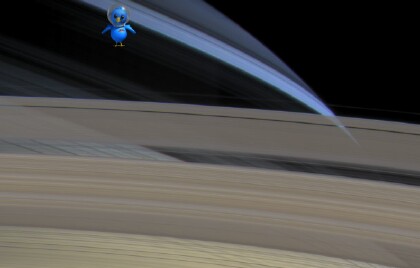Social Networking and Robotic Space Exploration

NASA JPL Saturn Twitter Wallpaper detail
For those of you who like to follow NASA's robotic exploration of space, here is a list of links to NASA JPL (Jet Propulsion Laboratory) related missions and projects social networking web pages.
- Asteroid Watch on Twitter: http://twitter.com/asteroidwatch
- Cassini on Twitter: http://twitter.com/CassiniSaturn
- Earth Vital Signs on Twitter: http://twitter.com/EarthVitalSigns
- NASA JPL blog, with posts from scientists and engineers: http://blogs.jpl.nasa.gov/
- NASA JPL Education page on Twitter: http://twitter.com/NASAJPL_Edu
- NASA JPL on Facebook: http://www.facebook.com/NASAJPL
- NASA JPL on Flickr: http://www.flickr.com/photos/nasa-jpl/
- NASA JPL on Twitter: http://twitter.com/nasajpl
- NASA JPL on Ustream: http://www.ustream.tv/channel/nasajpl
- NASA JPL on YouTube: http://www.youtube.com/user/JPLnews
- NASA JPLnews YouTube: http://www.jpl.nasa.gov/links/youtube.html
- Mars Exploration Rovers on Twitter: http://twitter.com/MarsRovers
- Mars Phoenix on Twitter: http://twitter.com/MarsPhoenix
- Mars Science Lab on Twitter: http://twitter.com/MarsScienceLab
- PlanetQuest on Twitter: http://twitter.com/PlanetQuest
Billed as being wallpapers for Twitter, there is a nice collection of images that you can use as wallpaper for your desktop or web site at the NASA JPL Free Twitter Wallpaper Page. The only caveat is that each image is tagged with a little blue bird in a space suit. This post's illustration is a full sized reproduction of the section of a Cassini image of Saturn that contains the blue bird astronaut.
A full list of all NASA-related social networking Web sites can be found at http://www.nasa.gov/collaborate/index.html
| Return to the Blog Index | This entry was posted on Wednesday, October 14th, 2009 at 5:59 pmand is filed under Space Exploration.
One Response to “Social Networking and Robotic Space Exploration”
-
The future of human space exploration looks bleak. After making great leaps 50 years ago, stagnation has taken over. No human has left Earth orbit in 37 years, and NASA's current unambitious goals look to be further delayed or scaled back.